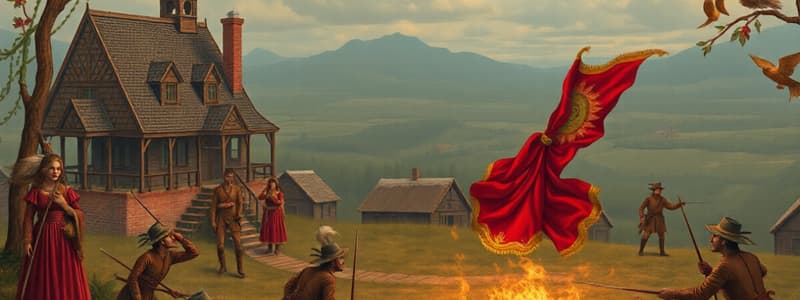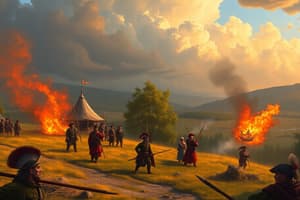Podcast
Questions and Answers
The French and Indian War was primarily about ______ and trade.
The French and Indian War was primarily about ______ and trade.
territories
During the 1750s, the three largest populations in North America were French colonists, English colonists, and ______ tribes.
During the 1750s, the three largest populations in North America were French colonists, English colonists, and ______ tribes.
Native American
The French relied heavily on alliances with Native Americans, such as the ______ Confederacy.
The French relied heavily on alliances with Native Americans, such as the ______ Confederacy.
Wabanaki
Not all Native Americans sided with the French; some tribes, like the Iroquois Confederacy, fought for the ______.
Not all Native Americans sided with the French; some tribes, like the Iroquois Confederacy, fought for the ______.
France viewed the Ohio Valley as an essential link between its colony in Canada and the lands claimed along the ______ River.
France viewed the Ohio Valley as an essential link between its colony in Canada and the lands claimed along the ______ River.
The British aimed to combat French interference with land grants to the _____ Company.
The British aimed to combat French interference with land grants to the _____ Company.
To counter French influence, the British supplied _____ with arms and encouraged them to attack French settlements.
To counter French influence, the British supplied _____ with arms and encouraged them to attack French settlements.
The raid by French soldiers and Algonquin warriors targeted _____, Britain's largest settlement in the area.
The raid by French soldiers and Algonquin warriors targeted _____, Britain's largest settlement in the area.
Marquis Duquesne was appointed governor of _____ in 1752.
Marquis Duquesne was appointed governor of _____ in 1752.
Captain Jacques Saint-Pierre was the commander of Fort _____ when Washington delivered the Virginia governor's demands.
Captain Jacques Saint-Pierre was the commander of Fort _____ when Washington delivered the Virginia governor's demands.
Fort _____ was the name chosen for the new British fort to be built in the contested territory.
Fort _____ was the name chosen for the new British fort to be built in the contested territory.
The Battle of _____ Glen is considered the first battle of the French and Indian War.
The Battle of _____ Glen is considered the first battle of the French and Indian War.
Despite Washington's efforts, Fort Necessity was attacked by French Canadian forces leading to his _____ from the fort.
Despite Washington's efforts, Fort Necessity was attacked by French Canadian forces leading to his _____ from the fort.
The Albany Congress aimed to ease tensions between _____ and colonists.
The Albany Congress aimed to ease tensions between _____ and colonists.
Major General Edward _____ led two Irish brigades to North America with a mission to reclaim the Ohio Valley.
Major General Edward _____ led two Irish brigades to North America with a mission to reclaim the Ohio Valley.
Flashcards are hidden until you start studying
Study Notes
The Ohio Valley Dispute
- The Ohio Valley was a key territory for both the French and the British colonial expansion.
- French saw it as a vital link between Canada and their Mississippi holdings.
- British saw it as interfering with land grants to the Ohio Company by Virginian colonists.
- This dispute was the primary catalyst for the French and Indian War.
Native American Involvement
- Native American tribes were caught in the middle of the conflict between French and British.
- Some tribes fought for the French, others for the British, while others remained neutral.
- The French relied heavily on alliances with tribes like the Wabanaki Confederacy, Abenaki, and Algonquin.
- The British, on the other hand, allied with tribes like the Iroquois Confederacy and the Catawba.
- Native American goals were primarily to prevent either side from gaining more territory and to protect their own interests.
The War's Early Stages
- Initial skirmishes happened between 1754 and 1755.
- The Battle of Jumonville Glen in 1754, led by George Washington, is considered the first battle of the war.
- The French, under Marquis Duquesne, asserted control of the Ohio territory.
- The British, under Governor Dinwiddie, tried to counter this advance and commissioned Washington to deliver a letter demanding French withdrawal.
- The French, captured Fort Prince George, constructed Fort Duquesne in its place, and later attacked Fort Necessity, forcing Washington to retreat.
The British Response and the Albany Plan
- The British, facing early setbacks, recognized the need for increased military strength and cooperation among colonies.
- The Albany Congress, held in 1754, aimed to ease tensions between colonists and Native Americans and prepare for war.
- The Albany Plan, proposed by Benjamin Franklin, emphasized colonial unity and mutual defense.
The Turning Point of the War
- The British suffered significant losses in the early years of the war, including General Braddock's defeat at the Battle of Monongahela.
- In 1756, Britain formally declared war on France, officially commencing both the French and Indian War and the Seven Years' War.
- The French had a series of victories initially, with Louis-Joseph Montcalm leading the French forces.
- The siege of Fort William Henry in 1757, while a French victory, led to the massacre of British prisoners by Montcalm's Indian allies, straining the French relationship with Native Americans.
British Victories and the "Annus Mirabilis"
- The British, under William Pitt's leadership, implemented new strategies, including bolstering colonial militias, raising funds, and offering colonists incentives.
- The tide began turning in favor of the British, with victories against the French at Fort Duquesne and Louisbourg.
- 1759 was a year of major British victories, known as "Annus Mirabilis," including the Battle of Quebec, a crucial victory that gave British control over much of North America.
The End of the French Threat
- The Battle of Quebec was the last major battle of the French and Indian War.
- French attempts to retake Quebec in 1760 failed due to a British naval victory at the Battle of Restigouche.
- The French surrendered Montreal in 1760, effectively ending French military presence in North America.
Consequences of the War
- The Treaty of Paris in 1763 officially ended the French and Indian War.
- It resulted in France ceding all of its mainland North American possessions east of the Mississippi to Great Britain.
- Spain gained lands west of the Mississippi and ceded Florida to Great Britain.
- The war left Great Britain deeply indebted, leading to increased taxation on the American colonies and setting the stage for the American Revolution.
Studying That Suits You
Use AI to generate personalized quizzes and flashcards to suit your learning preferences.




